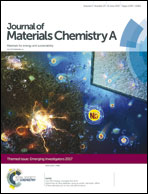A critical review on tin halide perovskite solar cells†
Abstract
APbI3−xBrx perovskite solar cells with the bandgap of ∼1.5–1.6 eV, where A represents caesium, methylammonium, formamidinium and mixtures thereof, currently present certified efficiencies very close to those of established thin film technologies (such as CIGS and CdTe) and are thus one of the most important optoelectronics. To restrict the use of lead, as well as to tune the band gap of the material close to the optimum according to the Shockley–Queisser limit (being 1.34 eV), substitution (total or partial) of Pb2+ by Sn2+ should take place. In this review, we present results on single junction solar cells, utilizing CsSnI3−xBrx, CH3NH3SnI3−xBrx or NH2CH![[double bond, length as m-dash]](https://www.rsc.org/images/entities/char_e001.gif) NH2SnI3−xBrx perovskites as absorbers, as well as a mixture of Sn2+/Pb2+ being adopted as the metal binary cation, reducing the bandgap to 1.2–1.4 eV. We also highlight very recently recorded efficiencies of perovskite-on-perovskite tandem solar cells, produced by the combination of the above low band gap materials with typical highly performing semi-transparent APbI3−xBrx perovskites of a higher band gap (close to 1.6–1.8 eV). We discuss these fascinating results, focusing on some key points such as, among others, the role of the tin compensator/reducing agent (usually SnF2) during perovskite crystallization. In addition, we present the critical challenges that currently limit the efficiency/stability of these systems and propose prospects for future directions.
NH2SnI3−xBrx perovskites as absorbers, as well as a mixture of Sn2+/Pb2+ being adopted as the metal binary cation, reducing the bandgap to 1.2–1.4 eV. We also highlight very recently recorded efficiencies of perovskite-on-perovskite tandem solar cells, produced by the combination of the above low band gap materials with typical highly performing semi-transparent APbI3−xBrx perovskites of a higher band gap (close to 1.6–1.8 eV). We discuss these fascinating results, focusing on some key points such as, among others, the role of the tin compensator/reducing agent (usually SnF2) during perovskite crystallization. In addition, we present the critical challenges that currently limit the efficiency/stability of these systems and propose prospects for future directions.

- This article is part of the themed collections: Recent Review Articles and Journal of Materials Chemistry A Emerging Investigators


 Please wait while we load your content...
Please wait while we load your content...